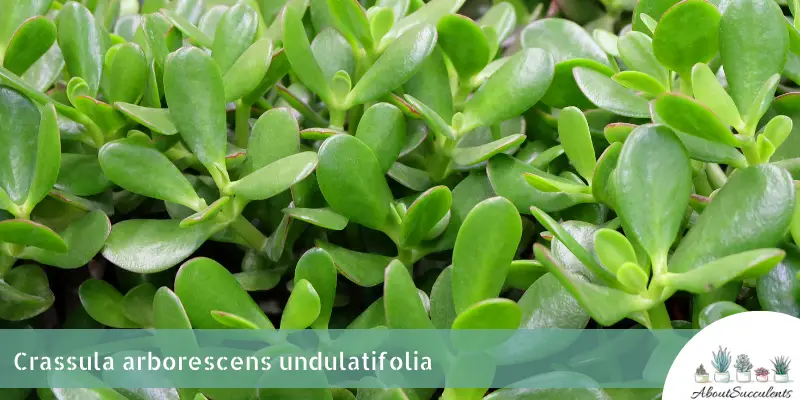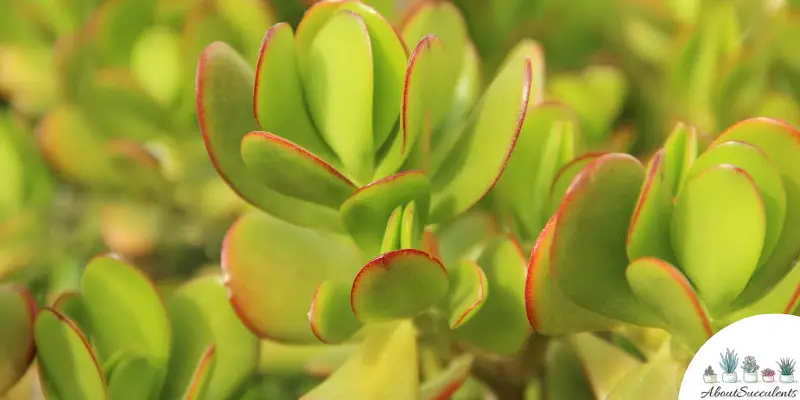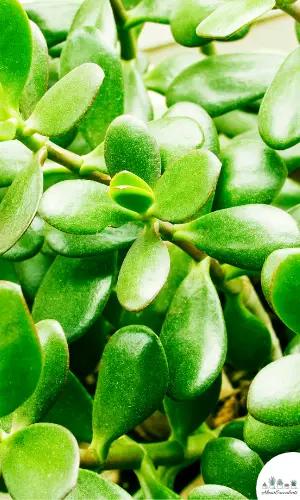
Crassula Arborescens Undulatifolia is a mesmerizing succulent that’s easily identifiable by its thin, wavy, bright-green colored leaves that resemble ripples of water on thick, fleshy branches.
The leaves of Crassula Arborescens Undulatifolia are accented with green dots while its edges are tinted with a purple color.
This succulent is native to the Eastern Cape of South Africa and is a member of the Crassulaceae family. It’s also commonly known as Ripple Jade Plant.
Fully-matured Ripple Jade Plant can reach a height of 1.2m or 4 feet. The Crassula forms rosettes that can grow to a width of 1m or 3 feet.
In the springtime, Crassula Arborescens Undulatifolia can surprise you with pink to white, star-shaped flowers.
General Information
Also known as: Ripple Jade Plant
Plant Family: Crassulaceae
Origin: Eastern Cape in South Africa
Height: 1.2m (4”)
Exposure: Full to partial sunlight for up to 6 hours.
Water Needs: Give water only when the soil is 100% dry; more frequently in the summer and significantly less during winter.
Soil Type: 50/50 potting soil and pumice plus perlite and chicken grit.
Soil pH: 6.1 to 6.5.
How to Grow and Care for Crassula Arborescens Undulatifolia

Crassula Arborescens Undulatifolia is a type of succulent that’s grown in popularity because it’s a no-frills plant to grow and care for.
Ripple Jade Plant is ideal for those who barely have time to look after their succulents. You don’t have to dote over this plant. As long as it gets enough sunshine and water only when needed – this Crassula will thrive for years.
Sunlight
Crassula Arborescens Undulatifolia will do well with either full or partial sunlight. In the outdoors, plant Crassula in an area that gets 6 hours of morning or late afternoon sunlight.
As a houseplant, place Ripple Jade Plant near a window that receives 4 to 6 hours of sunlight per day.
It’s important to note that this type of succulent isn’t cold-hardy and will not grow properly in regions where the temperature can fall below -6.7° C ( 20° F).
If your area gets colder than this, we recommend planting Crassula in a pot that can be moved indoors.
Watering

Ripple Jade Plant has typical watering needs of succulents. Only water the soil when it’s completely dry to avoid the occurrence of root rot.
To find out if the soil is ready for watering, insert a stick 1-2” into the soil. Pull out the stick and if it feels dry, prepare to give the soil a good soaking.
A common mistake by succulent growers is to water the plant. Don’t do this. Always water the soil. If you water overhead and drench the plant, it will remain moist for some time.
Pot and Soil
If you’re in the market for a pot, choose one that’s unglazed and made of either ceramic or terracotta. These materials help the soil lose moisture faster which is good for Crassula Arborescens Undulatifolia.
Make sure the pot has drain holes at the bottom. You’ll know if the soil has received the right amount of water when you see the drain holes leaking. Remove the excess water that’s collected on the tray.
The ideal soil for Ripple Jade Plant is a standard potting mix with added materials for improved drainage. You can do a 50/50 soil to pumice mix then add in perlite and chicken grit.
How to Propagate Crassula Arborescens Undulatifolia
If you want to add to the numbers of your Crassula Arborescens Undulatifolia, there are 2 methods you can use to propagate the species – the Leaves or Offsets methods.
Method 1 – Leaves
Step 1: Choose a healthy leaf near the main plant.
Step 2: Perform a careful twist and pull on the leaf or cut it off with a sterilized knife. To guarantee a successful propagation, make sure no part of the leaf is left on the stem.
Step 3: Allow the leaves to develop calluses by letting them dry out in a warm area for up to 3 days.
Step 4: When the leaves have callused over, place them on a well-draining potting soil mix.
Step 5: Look out for signs of the roots growing out of the leaves. Until such time that the roots have appeared, keep the soil moist by frequently misting it with water.
Step 6: Once the roots have firmed up, only water the soil whenever it’s gone dry.
Method 2 – Offsets
Step 1: Use a sterilized and sharpened knife to cut off the offsets that form as rosettes on the main plant.
Step 2: Let the offsets develop calluses over 2 to 3 days by leaving them to dry out in a warm area.
Step 3: Plant the offsets in well-draining soil.
Step 4: Water the soil when it has dried out completely.
Frequently Asked Questions
Is Crassula Arborescens Undulatifolia Toxic to Cats and Dogs?
Crassula Arborescens Undulatifolia is listed on the website of the American Society for the Prevention of Cruelty to Animals (ASPCA) as a succulent plant that can be harmful to your cats and dogs.
Keep your pets away from Ripple Jade Plant. If you see your pet vomiting, bring the animal to the veterinarian right away.
Why Is My Crassula Arborescens Undulatifolia Dying?
The more common cause of succulents dying is root rot which often goes unnoticed until it’s too late. Root rot is caused by overwatering. Another possible cause of death for your Crassula Arborescens Undulatifolia is that it’s been infested by disease-causing pests.
If you catch the symptoms of overwatering and pest infestation, you can still nurse Ripple Jade Plant back to health.
Overwatering
Overwatering causes root rot because the plant’s roots are kept in a moist environment for a long period of time. The cells of the roots continue to expand until they open up and become susceptible to infection.
In the summertime, the soil usually dries out within 7 to 10 days. If the soil of Crassula Arborescens Undulatifolia is still moist after 10 days, it’s possible that the soil you used doesn’t have good drainage properties.
It would be a good idea to repot Ripple Jade Plant in a ceramic or terracotta pot with good quality potting soil with pumice added for better drainage.
If you notice discoloration in the leaves and stems of your succulent, this is a sign that the fungal infection is making its way out. Cut the discolored parts right away with a pair of sterilized garden scissors or a knife.
Do the same with the roots. Remove all of the roots that have rotted away and let your plant dry out as you prepare the re-potting process.
Pest Infestation
Mealybugs, scale insects, and aphids will find Crassula Arborescens Undulatifolia even when it’s a houseplant.
These freeloading pests will make your beloved succulent their home and drink away its sap which carries a lot of important nutrients.
Along the way, their activities can leave a residue that can cause mildew and fungal infection.
Look for white, powdery substances on your succulent plant. These are signs that pests have nestled in Ripple Jade Plant. Remove the substances with a cotton ball that’s been dipped in 70% isopropyl alcohol.
Then, spray the plant with neem oil to keep pests away.
If Crassula Arborescens Undulatifolia is growing in ideal conditions, it will bloom pink to white, star-shaped flowers in the spring.
Last Updated on June 9, 2022 by Sofia Lara